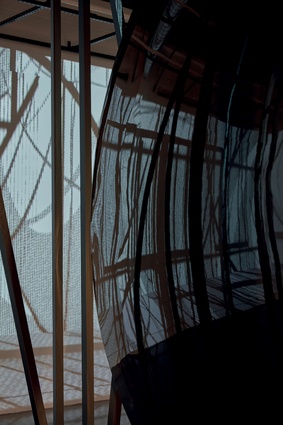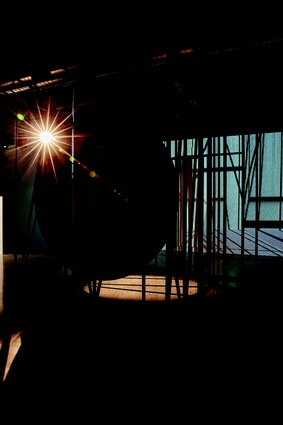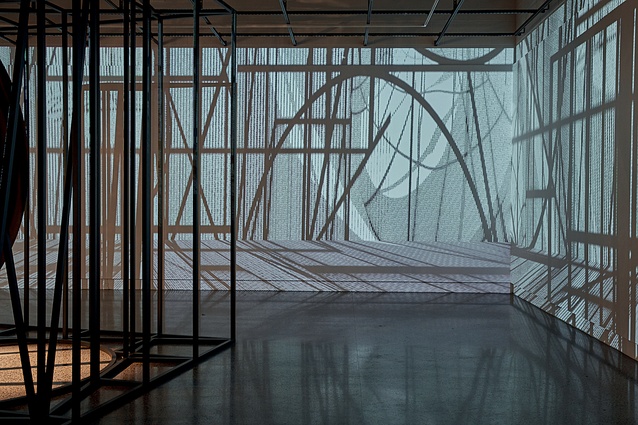Final thoughts: Penumbral Reflections
Chris Barton explores Paterson Architecture Collective’s commissioned architectural installation at Objectspace in Auckland.
Standing in Objectspace’s darkened gallery just a few centimetres away from the front of the giant convex mirror – the centrepiece of the Penumbral Reflections exhibition – messes with your head. You want to reach out and touch and yet the reflection is so far away that an uncanny distortion deep inside the mirror makes you question just what is real.

The exhibit, created by Sarosh Mulla and Aaron Paterson of Paterson Architecture Collective (PAC), comprises a stainless-steel mirror inside the aluminium skeleton frame of a 3.6m cube, skewed in the centre of the room. The cage-like cube is animated by moving projections of simulations of the frame and mirror from four projectors mounted on two of the gallery’s walls casting across the cage to the opposite walls. The result – sinewy shadows of the cage bars cast on the floor and the walls amongst moving simulations of the same thing – is intriguing, a little bit threatening, ominous.
“As architects, we are always in between the moment of imagining some sort of future and the harsh reality of that realisation in the physical form,” Mulla told me. “We are trying to put you in the shadow between that kind of zone and show you that place we occupy, where we feel all our creativity lies.” It’s intended as architecture not art and certainly invites inhabitation as viewers enter through the perimeter bars to its circular centre.
Removed from the exhibition and relocated to the Waikereru Ecosanctuary in Gisborne, the cubed frame will eventually have another purpose – the housing of a circular star-gazing observatory. This will be a raised, open-air platform from which viewers can peer through a telescope at the blackest of starry skies.
In Objectspace in Ponsonby, the cubed frame represents aspects of architecture in the making – a modelled thinking process – showing the grid abstracted as a planning and programmatic tool and, also, as a point of departure for unusual forms. That departure is realised in the space created by a smaller 2.5m, angled cube nested within the 3.6m cube: a transition zone between the two cubes. Paterson calls it “an occupied façade”.

It’s in this in-between space on one side of the cube that the big mirror resides. It, too, removed from the frame, will eventually be relocated as a supersized Claude Glass at the Waikereru Ecosanctuary. The quantum shift in scale of the device is audacious. The Claude Glass is, traditionally, a small, hand-held, black mirror used by English artists of the picturesque movement in the late 18th and early-19th centuries to foreshorten the reflection of a landscape view to conform to established ideals of beauty. At the Waikeruru Ecosanctuary, the supersized black mirror will present a startling political reversal – a reflection of the viewer immersed in a picturesque landscape in the process of recovery.
In Objectspace, the big Claude Glass reflects, occupies and distorts space – especially through the projected and reflected simulations created in 3D-gaming software from screen prints of the cage and animated as sliding planes. When viewed in the curved face of the Claude Glass, the projections produce two penumbral zones of half shadow, similar to what is seen in a lunar eclipse. The projections make parts of the aluminium frame silvery and alive as the moving animations crawl across its surface and produce unease about what is there – a game of spot-the-difference between simulated, real and spatial shadow.
Penumbral Reflections places architecture in the field of representation, not just building – a representation that is always being edited and curated and which challenges the notion of a represented reality as fundamentally flawed. The exhibit is also a machine for making, like a preparatory drawing: an ‘as if’ space for the viewer to enter in order to watch an idea in the process of becoming a form.
Penumbral Reflections: Sarosh Mulla and Aaron Paterson – PAC was commissioned by Objectspace and sponsored by The Warren Trust. The installation occupied Objectspace from 12 May to 24 June 2018 and will be reinstalled at Waikereru Ecosanctuary near Gisborne early in 2019.















